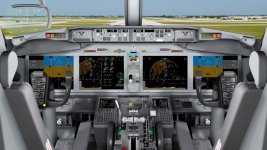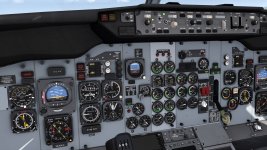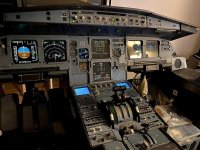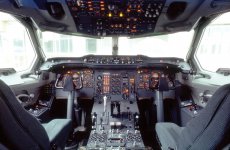6L6 -- aren't Airbus's commercial craft all fly-by-wire now? Please do correct me if I'm wrong but wasn't that system was partially implicated in the Air France crash in the mid-Atlantic? .
My (limited) understanding is that Airbus have been FBW from the beginning the idea being that (within the laws of physics) all airbus models respond the same way to stick input. The fun comes when the computers cannot parse the input and the plane switches from normal law to alternative law flying. From what I can tell this basically comes down to the system saying 'you are on your own fleshies'. From my reading the Air France crash was due to a combination of factors triggered by a freezing pitot tripping the plane into alt law flying and then the junior member of the flight crew freaking a bit and pulling the plane into a stall. They discovered that if one pilot is pulling back hard and the other pushing forwards the two stick inputs are added. I had always assumed there was a big friendly 'I have control' button to switch between pilot and co-pilot, but I have no idea how that sort of thing is drilled for when it goes non-linear fast.
and the plane switches from normal law to alternative law flying
Flight Control Laws - SKYbrary Aviation Safety
George
Question for Jim T: AOA is the angle between fuselage centerline and the external air stream, correct?
Can we assume that the airstream is in principle horizontal?
If that is so, why not detect AOA as the fuselage centerline angle referred to vertical or horizontal, as detected by an internal gyro sensor?
Jan
Can we assume that the airstream is in principle horizontal?
If that is so, why not detect AOA as the fuselage centerline angle referred to vertical or horizontal, as detected by an internal gyro sensor?
Jan
I'd rather fly with a computer pilot. s long as everything goes resonable to plan. But cant stop to wonder how an AI today would had handled the Hudson River situation...
//
//
If that is so, why not detect AOA as the fuselage centerline angle referred to vertical or horizontal, as detected by an internal gyro sensor?
Jan
Doesn't the revised EASA regs for the 737Max demand input into MCAS from both fitted AoA sensors plus a 3rd derived value?
I suspect the derived value is based on what you said.
Angle of attack is the difference between the wings chord line and the "relative wind" - the angle between the chord line and the movement path of the center of mass of the aircraft. Pitch attitude (where the nose is pointing) actually doesn't have much to do with it...



An externally hosted image should be here but it was not working when we last tested it.

Last edited:
For a great example of the nose (and wing) pointing up, but the flight path going down, just look at Concorde landing. Very high AOA.
Concorde Landing | Concorde | London | Thames Rushes | 1980's - YouTube
Concorde Landing | Concorde | London | Thames Rushes | 1980's - YouTube
Thank you George. I am slightly less ignorant now, but a lot of that still went over my head. But from what I do understand looks like Air France 447 switched to Alt1.
What I have also found out is that Airbus didn't have cockpit AOA indication on that model (but was introduced after the crash).
Air France 447 in a nutshell - (oversimplified, this is the quick and dirty version)
Aircraft flew through top of cloud containing extreme amounts of supercooled moisture, Pitot tubes simultaneously iced up, some flight instruments became unreliable, and aircraft went into flight control law "alt 2" because of the unreliable pitot information. Aircraft control surfaces and flight computers all operative, functional and working as designed. Engines working normally.
Pilot flying at the time misinterpreted conflicting information (some of it good, some missing) and through his inputs, stalled the airplane, and continued pro-stall control inputs for almost the entirety of the remaining time.
Airplane instruments return to normal operation but pilot still stalling the damn plane because he thinks that the stall warning that's been going on since the initial stall is unreliable indication. (It's not.) Aircraft is no longer flying, but falling/traveling down, with the mass of it going down/forward at about a 30deg angle and the nose pitched 10deg above the horizon, for an angle of attack of 40deg, and the wing is deeply stalled.
Aircraft flight controls still attempting to do what is asked (as the pilot essentially is pulling back on the stick continuously the entire time as he's not aware he's doing it...) and the stabilator tries to pitch the airplane up and gets to a full nose up position.
This is when the captain tries to push forward, and nothing seems to happen, as the small movable elevator (which is functioning properly) on the back of the tailplane cannot overpower the rest of the stabilator.
Anyway, the eventual vertical velocity component (straight down) at the inevitable meeting of the Atlantic Ocean is 108 knots (200 km/h; 124 mph) which instantly relieved all aboard of the terror of the last few minutes.
Air France Flight 447 - Wikipedia
Chaos In The Cockpit - The Disappearance of Flight 447! | Full Length Documentary - YouTube
Aircraft flew through top of cloud containing extreme amounts of supercooled moisture, Pitot tubes simultaneously iced up, some flight instruments became unreliable, and aircraft went into flight control law "alt 2" because of the unreliable pitot information. Aircraft control surfaces and flight computers all operative, functional and working as designed. Engines working normally.
Pilot flying at the time misinterpreted conflicting information (some of it good, some missing) and through his inputs, stalled the airplane, and continued pro-stall control inputs for almost the entirety of the remaining time.
Airplane instruments return to normal operation but pilot still stalling the damn plane because he thinks that the stall warning that's been going on since the initial stall is unreliable indication. (It's not.) Aircraft is no longer flying, but falling/traveling down, with the mass of it going down/forward at about a 30deg angle and the nose pitched 10deg above the horizon, for an angle of attack of 40deg, and the wing is deeply stalled.
Aircraft flight controls still attempting to do what is asked (as the pilot essentially is pulling back on the stick continuously the entire time as he's not aware he's doing it...) and the stabilator tries to pitch the airplane up and gets to a full nose up position.
This is when the captain tries to push forward, and nothing seems to happen, as the small movable elevator (which is functioning properly) on the back of the tailplane cannot overpower the rest of the stabilator.
Anyway, the eventual vertical velocity component (straight down) at the inevitable meeting of the Atlantic Ocean is 108 knots (200 km/h; 124 mph) which instantly relieved all aboard of the terror of the last few minutes.
Air France Flight 447 - Wikipedia
Chaos In The Cockpit - The Disappearance of Flight 447! | Full Length Documentary - YouTube
Jim, I wonder whether modern jet fighters have a vane flapping on the outside ;-)
From the F-35 page:
AoA refers to the angle between an aircraft wing’s chord line, the imaginary straight line between the wing’s leading and trailing edges, and the aircraft’s flight path. It’s not to be confused with attitude, the jet’s relation to the Earth, which is seldom the same as AoA.
As you said. As I see it, neither of those data points need an ancient, primitive outside vane. (He said, slightly combative;-)
Edit: Alternatively pressure based probes are also used which look similar to pitot tubes traditionally used to measure altitude and airspeed. These probes have multiple ports and the pressure difference detected between the ports is used to determine the AOA of the aircraft.
Jan
From the F-35 page:
AoA refers to the angle between an aircraft wing’s chord line, the imaginary straight line between the wing’s leading and trailing edges, and the aircraft’s flight path. It’s not to be confused with attitude, the jet’s relation to the Earth, which is seldom the same as AoA.
As you said. As I see it, neither of those data points need an ancient, primitive outside vane. (He said, slightly combative;-)
Edit: Alternatively pressure based probes are also used which look similar to pitot tubes traditionally used to measure altitude and airspeed. These probes have multiple ports and the pressure difference detected between the ports is used to determine the AOA of the aircraft.
Jan
Last edited:
Ref Airfrance accident
Section 2, 3.
https://bea.aero/docspa/2009/f-cp090601.en/pdf/f-cp090601.en.pdf
The amount of aural/visual warnings, ECAM messages, MFD mode changes and rolling pages in a glass cockpit during a malfunction/emergency situation is overwhelming.
The human/computer interface through multiple displays/info overdose in case of emergency is a serious issue.
Need for tedious simulator training/retraining of flight crew can not be overstressed.
Flight systems design transparently documented in Flight Operation manuals can not be overstressed.
George
Section 2, 3.
https://bea.aero/docspa/2009/f-cp090601.en/pdf/f-cp090601.en.pdf
The amount of aural/visual warnings, ECAM messages, MFD mode changes and rolling pages in a glass cockpit during a malfunction/emergency situation is overwhelming.
The human/computer interface through multiple displays/info overdose in case of emergency is a serious issue.
Need for tedious simulator training/retraining of flight crew can not be overstressed.
Flight systems design transparently documented in Flight Operation manuals can not be overstressed.
George
Attachments
6L6, George: Thank you. I do find the human factors aspects fascinating, mainly because my brain is not wired to prioritise multiple sources of (possibly) conflicting data in the way required. So I have enormous respect for those who can.
The BBC filmed an RAF pilot some years back who specialises in teaching figher pilots how to recover from flame out and subsequent loss of control. They filmed him stalling the plane at about 40k feet over the sea off the Norfolk coast and recovering. I couldn't even start to comprehend how he was calmly running through the steps to stop a spin then get the engine restarted.
The BBC filmed an RAF pilot some years back who specialises in teaching figher pilots how to recover from flame out and subsequent loss of control. They filmed him stalling the plane at about 40k feet over the sea off the Norfolk coast and recovering. I couldn't even start to comprehend how he was calmly running through the steps to stop a spin then get the engine restarted.
When people talk about stalling an airliner, I always wondered why there wasn’t a simple mechanical device in the cockpit that directly indicated the nose- up angle. You could hang a small weight off a string and you’d get a clear indication.
In a crises, and at night, without the horizon as a reference, humans struggle to make sense of up or down, angle they’re at etc.
I’ve seen enough ‘Air Crash Disaster’ (been watching them for about 10 yrs ) to know it must be horrendous trying to recover a doomed plane. I’ve also quite a few shows where the pilots stalled the plane, and that’s what caused the crash, sometimes ultimately because of faulty sensor data.
In a crises, and at night, without the horizon as a reference, humans struggle to make sense of up or down, angle they’re at etc.
I’ve seen enough ‘Air Crash Disaster’ (been watching them for about 10 yrs ) to know it must be horrendous trying to recover a doomed plane. I’ve also quite a few shows where the pilots stalled the plane, and that’s what caused the crash, sometimes ultimately because of faulty sensor data.
Last edited:
My Christmas gift to Jan 🙂
Integrated-strapdown-air-data sensor system
Method for developing air data for use in flight control systems
Now, patent search shows technology on non-moving vane AoA sensors is here with us for a very long time (indicative evolution steps, then SW assisted)
Angle-of-attack indicator
Angle of attack sensing device
Pressure sensing instrument for aircraft
https://www.freepatentsonline.com/4378696.pdf
https://www.freepatentsonline.com/5205169.pdf
(announcement on 1992-1993 evaluation https://www.semanticscholar.org/pap...idel/c2c2876c180909e1a277451b585508bbcb8da040 )
https://www.freepatentsonline.com/6253166.pdf
https://www.freepatentsonline.com/6604029.pdf
Recent info on non-moving vane AoA sensors
https://www.icas.org/ICAS_ARCHIVE/ICAS2018/data/papers/ICAS2018_0625_paper.pdf
https://reader.elsevier.com/reader/...38DD6F3B11D23B7673ABDF4594BFD9E217EEAB7F54203
George
Integrated-strapdown-air-data sensor system
Method for developing air data for use in flight control systems
Now, patent search shows technology on non-moving vane AoA sensors is here with us for a very long time (indicative evolution steps, then SW assisted)
Angle-of-attack indicator
Angle of attack sensing device
Pressure sensing instrument for aircraft
https://www.freepatentsonline.com/4378696.pdf
https://www.freepatentsonline.com/5205169.pdf
(announcement on 1992-1993 evaluation https://www.semanticscholar.org/pap...idel/c2c2876c180909e1a277451b585508bbcb8da040 )
https://www.freepatentsonline.com/6253166.pdf
https://www.freepatentsonline.com/6604029.pdf
Recent info on non-moving vane AoA sensors
https://www.icas.org/ICAS_ARCHIVE/ICAS2018/data/papers/ICAS2018_0625_paper.pdf
https://reader.elsevier.com/reader/...38DD6F3B11D23B7673ABDF4594BFD9E217EEAB7F54203
George
There was a Standby (wet) Compass on the older airplanes. Totally self contained.When people talk about stalling an airliner, I always wondered why there wasn’t a simple mechanical device in the cockpit that directly indicated the nose- up angle. You could hang a small weight off a string and you’d get a clear indication.
There was and is one Attitude Display in front of each pilot (on the main EFIS display today, or “Artificial Horizon” on older versions).
There is one Standby Attitude Display in the middle of the front console
(look at pictures shown two posts above)
George
My Christmas gift to Jan 🙂
Integrated-strapdown-air-data sensor system
Method for developing air data for use in flight control systemsGeorge
😀
Jan
Boeing and the FAA cannot stop digging a deeper hole.
If another MAX crashes they will be at bottom of it
🙁
Isn't that the artificial horizon that all planes have bang in front of the pilot?
Yes. It depends on a gyroscope. In fact, planes used to have two or three gyroscopes. You could switch so the displays ran off one, or any two. This redundancy can save lives.
I don't know about the redundancy in the newer planes. It seems to me that safety is not exactly the number one priority any more. And the autopilot and warning systems depend on data from the gyroscope(s). Some autopilots will kick off it both, or two of the three, don't match. Again, I don't know how redundant these newfangled planes are, but I'm thinking the worst.
- Status
- Not open for further replies.
- Home
- Member Areas
- The Lounge
- 737 Max



